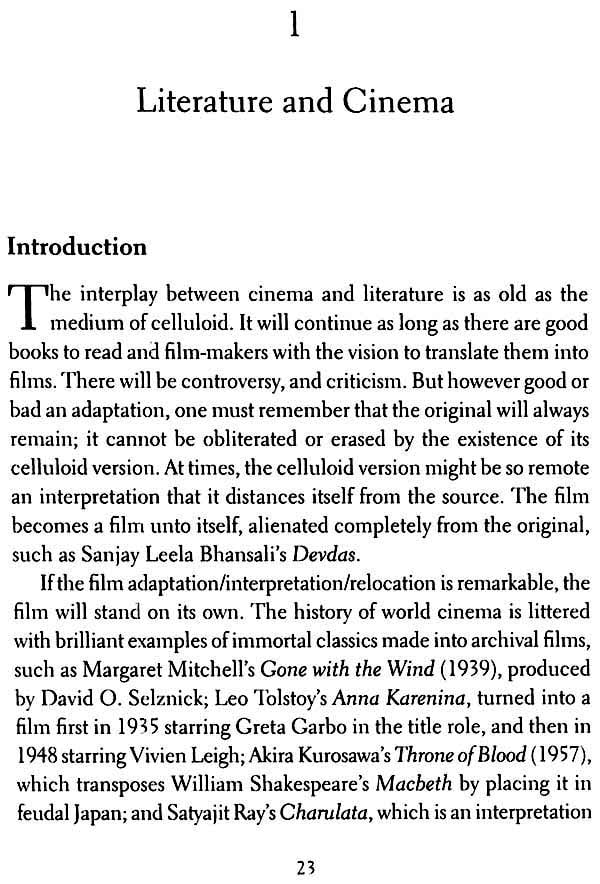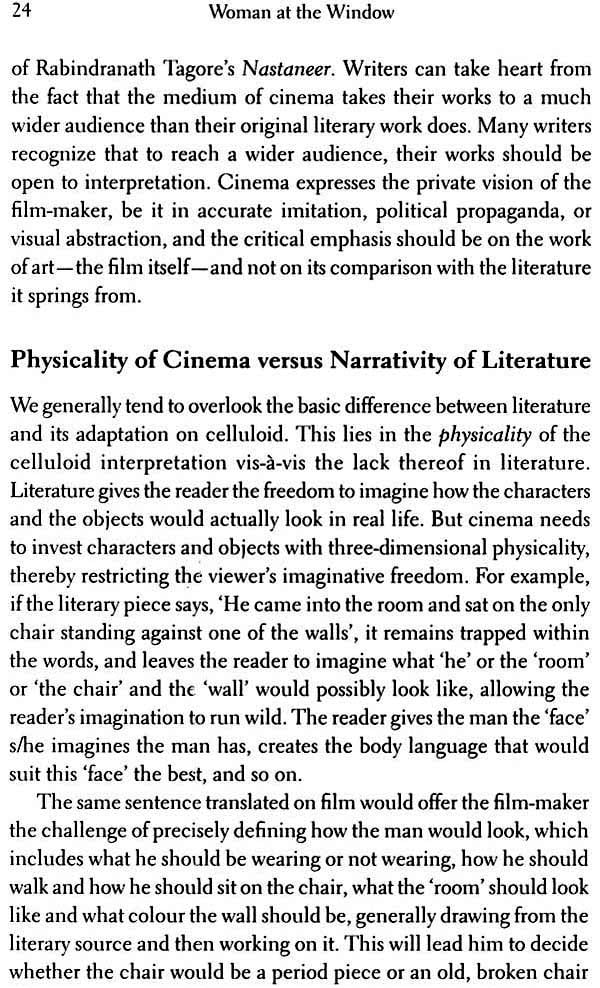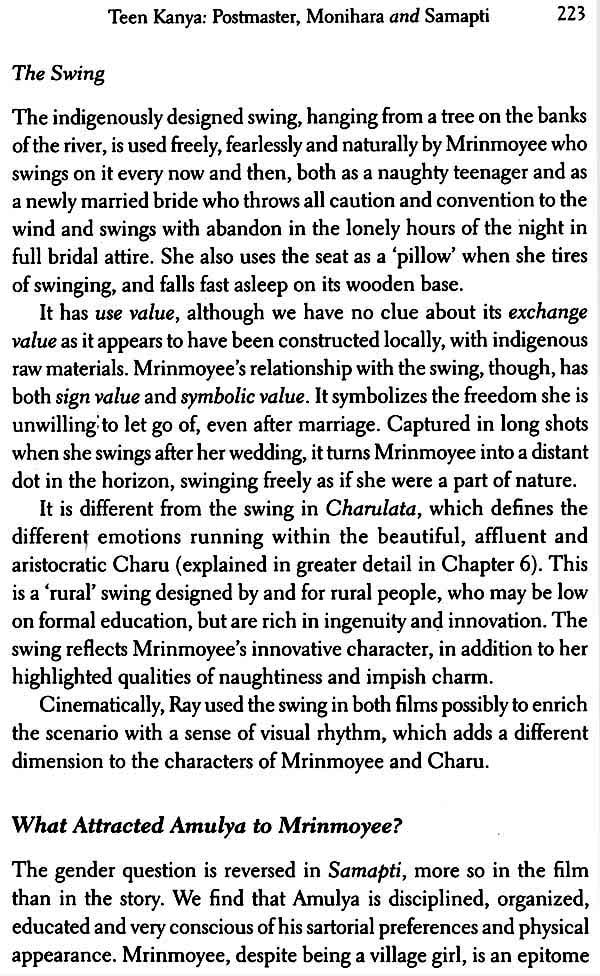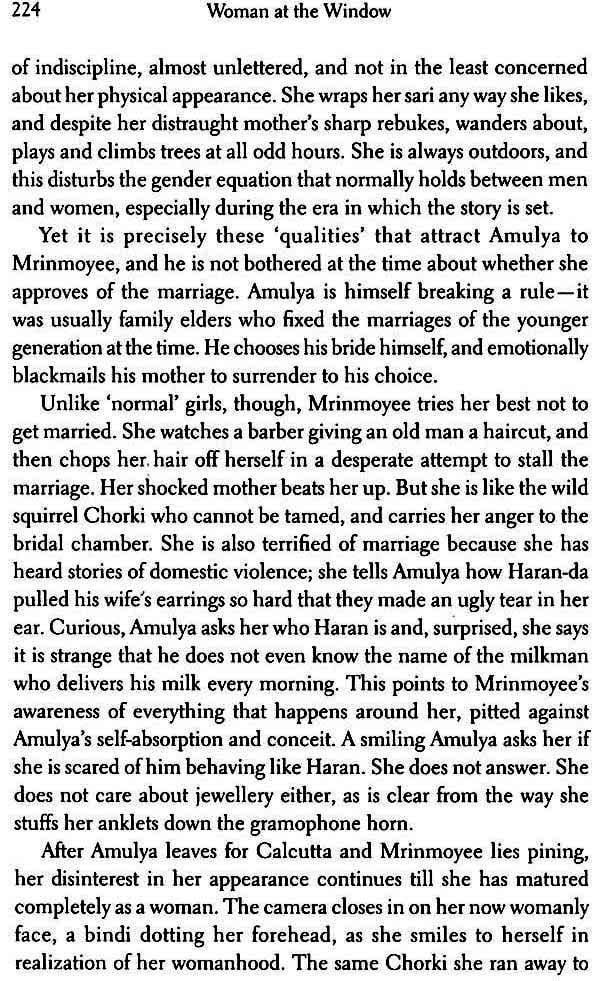
Woman at the Window
Book Specification
| Item Code: | NAO604 |
| Author: | Shoma A. Chatterji |
| Publisher: | Harper Collins Publishers |
| Language: | English |
| Edition: | 2017 |
| ISBN: | 9789351365020 |
| Pages: | 354 |
| Cover: | Paperback |
| Other Details | 8.0 inch X 5.0 inch |
| Weight | 310 gm |
Book Description
Cinematic conventions tend to be embedded in the patriarchal. The controlling look is always male, with women subjected to the gaze-voyeuristic, investigation, looking for titillation. Yet, Satyajit Ray’s cinema strove to steer clear of this. None of Ray’s women protagonists-most memorably in his adaptations of Tagore’s stories but true of the other films too-can be reduced to a cliché. They defy every imaginable stereotyping.
Woman at the Window attempts a completely new way of looking at Ray’s films in general, and his adaptations of Tagore in particular, through an examination of objects that are the familiars of his female protagonist. A lorgnette in Charulata, abox of the jwels in Monihara, a bag of gold coins in Ghara Baire, a squirrel in Samapti and, in the none-Tagore stories, a lipstick in Mahanagar and a hairpin on a rumpled pillow in Apur Sansar. What do these everyday objects subtly suggest about the characteristics of their owners and users? What role do they play in the lives of the characters? Do they offer a new dimension or perspective in the study of Ray’s cinema?
National Award-winning author Shoma A. Chatterji offers an entirely new understanding of the differences and synergy between Tagore’s original stories and Ray’s celluloid readings of them, as also fascinating material for anyone interested in cinema and gender.
Shoma A. Chetterji, film critic, journalist and author, won the National Award (1991) for Best film Critic Award from the Bengal Film journalist’ Association (1998). Her book Parama and Other Outsiders: The Cinema of Aparna Sen won the National Award for the best book on Cinema in 2003. She won a research fellowship from the National Film Archive, Pune, in 2003-2004, and a senior research fellowship from PSBT (Public Service Broadcasting Trust), Delhi. She won the second prize in the Sahitya Akademi’s Golden Short Story Translation Contest in 2007. She writes extensively on cinema and gender issues. She also covers media, human rights, development, child rights and contemporary issues in several print and electronic media publications across India. She has been on the panel of film juries at international film festivals and has presented papers on television and cinema at Thessaloniki, Greece, Mannheim, Stuttgart and University of Heidelberg, Germany, School of Sound, London, and Asian Film Center, Colombo, Sri Lanka. Besides contributing to many edited compilations on India cinema, she has author over twenty published currently contributes to The Tribune, www.upperstall.com, wwwIndiaTagore.org, One People, Vidura, Media, Trans World Features and Free Press Journal. She has been writing for thirty-five years and is based in Kolkata.
It is indeed an honour and a privilege to have been invited to write a foreword for this book. Shoma Chetterji is an institution when it’s come to India film criticism, and needs no introduction. She has for years written very well about all kinds of cinema-Indian and otherwise-and has been a tireless advocate of good cinema to be shown, seen and made here. In that, she is a comrade in a common cause.
The book I am supposed to introduce, however, reaches out to dimensions of cinema far beyond what we ordinary consider film criticism. Indeed, I was bit taken aback when the author invited me to write a foreword for a book on Satyajit Ray’s adaptations of Tagore’s literary works. I am no expert on Ray’s cinema, and most certainly not on Tagorean literature. However, a quick look at the book proposal, which informed me that is focused on the world of objects framing Ray’s cinema, was enough to persuade me accept Shoma-di’s generous invitation.
A number of things flashed through my mind as read the proposal, which made the book stand out for its unique subjects matter, and challenged me to grapple with an essential conundrum of film studies that this book seemed to throw into relief with effortless ease. The conundrum is a simple one: Why has no study of the system of objects underpinning a director’s oeuvre been done till date?
What mesmerized me when faced with this book was the fact that what I was looking at was indeed the first comprehensive study of the manner in which objects placed within the space of a film is a vital component of directorial vision; indeed, it is a crucial definer of the auteurial status of the film-maker as an artist with an unique vision of cinema. And the reason for being mesmerized was simply the obviousness of the centrality of objects of directorial vision, and the knowledge that no book had been written about so obvious a thing.
This is not to say that film theory has not focused in objects in cinema. A focus on objects within a filmic universe in film criticism is not surprising, given that the placement of objects towards a directorial is crucial to that basic element of cinema something all of us learn on our very first day at film theory-mise en scene. And it is precisely within the consideration of the mise en scene of the entire oeuvre of a director such as Max Ophuls that copious complements have been paid to the manner in in which Ophuls meticulously constructs a complex object world to frame his films. However, s having said that, no scholarly work on the subject has been forthcoming. And one can only wonder what one could do if one were to attempt a book on the object world making up Hitchcock’s cinema. It would most certainly be one of the most pleasurable of exercises in film analysis that one could imagine in all of cinema’s history.
To cut a long story short, we are therefore being very pleasantly presented with not only an intellectually stimulating novel slant on the relationship between Ray’s cinema and Tagorean literature, but also a landmark publication in film studies that is a first of its kind. In being so, the book therefore has the onerous task of representing not only the specific subject matter that it deals with, but also introducing a new analytical approach to film. Needless to say, the first task the book performs with aplomb-that of dissecting the manner in which objects, as very material things unto themselves, e absolutely central to the sense and meanings of Ray’s cinema.
It is sheer pleasure to read the author’s lucid analytical navigation through object after object in scene after scene expressions of aesthetic delectation that have marked generations of demotic a well as connoisseurial appreciation of Ray’s eye for `details’. If certain ‘simple things’ of childhood recalled mark the aesthetic eloquence of Charu’s intial writings, Ray’s cinema too performs some such task of creating a memory of ‘simple things’ in our pasts, which we can recall and write about with lyrical and lucid ease.
More importantly, the wonderful point the author makes is that it is precisely through the manner in which Ray plays up the materiality of his object world, something that cinemas allows him to do powerfully, that is filmic adaptations of Tagore novels or stories become autonomous as artistic creations independent of their source. This point will, I am sure, launch a thousand discussions not only in Ray and Tagore studies in particular, but for the relationship between film and literature in general.
The second task that the book performs-that of conceptually opening up a new terrain of cinematic thinking-will provide the reader with a rich and complex adumbration of existing theoretical literature on objects ranging from Baudrillard’s construction of a system of objects, to Igour Kopytoff’s landmark cultural biography of things. It also allow me, by way of concluding, to return to the vexing issue of the absence of a book such as this until now for film studies, and in doing so, place this book in certain new strands of continental philosophy (perhaps a bit beyond the book’s explicit remit)
In this respect, one of the first things that struck me when I started to engage with the book was its timed appearance with respect to the ascent in the West of something called ‘object-oriented philosophy’, most notably enumerated by Graham Harman, a member of the Speculative Realism group of philosophers, which includes, amongst other, the darling of contemporary French theory, Quentin Meillassoux. Dedicated to overturning the anthropocentrism of philosophical and social thought that holds human beings as the centre of all existence, Harman and few others have posited a radical autonomy of objects with respect to human will. Objects are things unto themselves and need to be seen as independent of human interest.
The Background
The modern world is as much globalized as it is materialistic, and flush with the dominance of commodities over people. Earlier, we would refer to commodities as objects. These were less demonstration-oriented and had values other than their physical existence or the price they were exchanged for. Even today, some people feel that some objects can become equally or more important than the subjects who own them or wish to own them, or are forced to part with them.
Where, in this materialistic world, does the ‘object’ fit in beyond its two basic, Marxist values-value-in-use and value-in-exchange? Do women fit into this scheme of objects when they are themselves considered objects? While we read fairy tales as children or listened to mythological stories from our mothers and grandmothers, children today are busy surfing the web and socializing on social networking sites. The more addicted they get to electronic and information technology for social and emotional support, the less they enter direct and active social relationships. So they almost do not notice the objects they are surrounded by or own, or are gifted with.
Over time, our lives have been redefined and reconstructed within a rapidly changing world on the information highway and communication technology. One of these changes our marginalization of objects, to the extent that they almost become invisible. We concede to being ruled by a commodity-centered universe rather than by an object-surrounded universe. A commodity- centered universe is dictated by money, advertising, marketing, promotion and its associated paraphernalia. An object-surrounded universe reaches out to emotional associations, along with nostalgia, memory and a psychological urge to hold on to and belong.
When a family shifts from its ancestral home to a sophisticated apartment in the city with modern fixtures already in place, the last choice among the objects the family chooses to take along is old, sepia-toned photographs of its predecessors framed in glass, because these are considered unimportant and, therefore, redundant. Are the portraits really redundant? Does our past mean little or nothing to us? These are questions that raise further questions about the value of objects in our lives, in the past, at present, and in the future.
The Problem
When a lover of cinema in general and Satyajit Ray’s cinema in the particular decides to write a book on his films, the writer is challenged by an encyclopedic ‘library’ of books, essays, research papers and seminar reports already authored on the great master’s work. When the same writer proposes to study Ray’s interpretation of Tagore’s literary classics, the task becomes even more challenging because the world of scholars and academics is flooded with experts across the world who have dedicated their lives studying Tagore from different viewpoints, adding their own perspectives, and giving new dimensions to their analysis, interpretation and research on Tagore. Even more difficult is wading through volumes of studies on the interconnections between Ray and Tagore, and sometimes, analyzing the two together through the literature-cinema dyad.
The best part of this reading is that you evolve your own concepts and ideas, drawing from the work that has already been done; and from this, you can discover what has not been done and that becomes your focus. After considering various aspects related to exploring Ray’s interpretation of Tagore, specifically in relation to the gender issue in his celluloid adaptation, this writer found that there is one specific area that was waiting to be tapped. This writer chanced upon Jean Baudrillard’s Object-Value System and later, Igor Kopytoff ‘s interpretation and study, Cultural biography of Things: Commoditization as a Process (1986). This writer believes that analytical and interpretative readings of cinema can lend themselves to read, analyze, interpret and/or question the allegorical potential of the visual and narrative use of objects, not in order to marvel at their realistic description on cinematic detailing through tools of cinematography, lighting, sound and editing, but more importantly, to discover their propose in the lives of the character/s in the film they are related to. Just changing one word in paragraph from Judith Fitterley’s Introduction on the Politics of Literature1 will point out the possibilities inherent in hidden areas of cinema that could form a subject of in-depth study. Fetterley writes:
| Foreword | ix | ||
| Introduction | 1 | ||
| 1 | Literatuer and Cinema | 23 | |
| 2 | Tagore, Women and Cinema | 57 | |
| 3 | The Cinematic Value of Objects | 105 | |
| 4 | Stayajit Ray, His Celluloid Women vis-à-vis the Cinematic Value of Objects | 144 | |
| 5 | Teen Kanya: Postmaster, Monihara and Samapti | 178 | |
| 6 | The Material Universe of Charu and Charulata | 226 | |
| 7 | Ghara Baire: Bimala and the Universe of Objects | 262 | |
| Notes | 296 | ||
| Bibliography | 322 | ||
| Index | 331 |
Sample Pages









